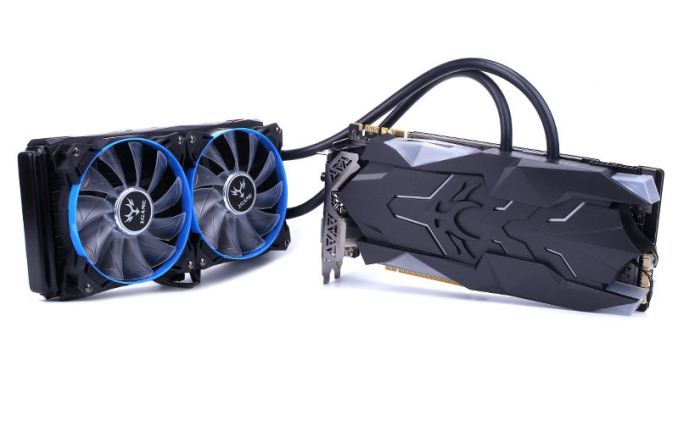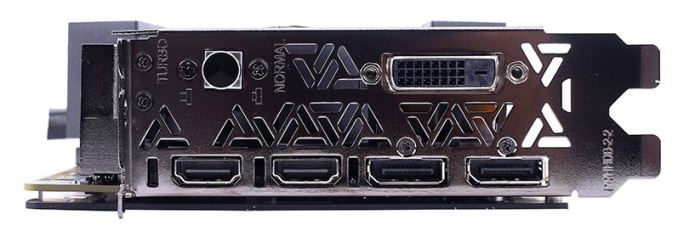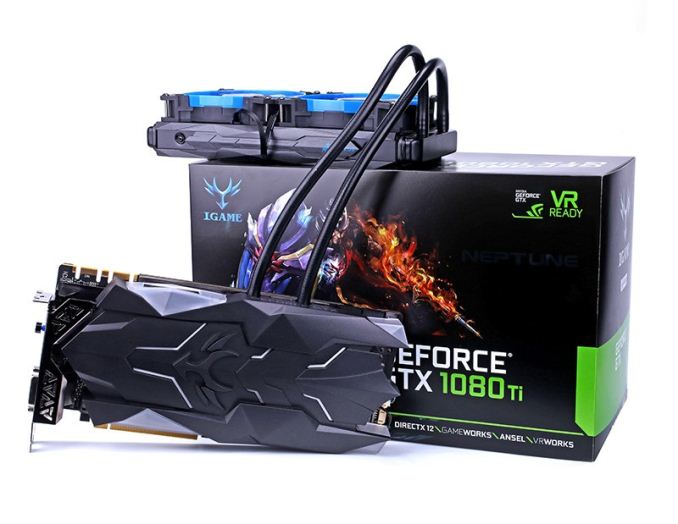Colorful Announces iGame GeForce GTX 1080 Ti Neptune W: All-in-One Liquid Cooling With 240mm Radiator
by Nate Oh on July 12, 2017 10:00 PM EST
The past few months have been full of announcements and releases for all-in-one liquid cooled graphics cards, and now Colorful is joining the fray with their iGame GeForce GTX 1080 Ti Neptune W. First teased at Computex 2017, the Neptune W comes equipped with an all-in-one closed loop cooling solution, featuring a novel 240mm radiator.
While Colorful is a China-based vendor, at Computex 2017 the company also disclosed plans to launch their iGame series cards worldwide, starting in Southeast Asia and Korea; Colorful already has branches in Germany, South Korea, and Vietnam. This follows previous information hinting at future market expansion with Colorful’s iGame GTX 1080 Ti Vulcan X OC. In the meantime, the Neptune W product page is only listed on their Chinese site.
| Colorful iGame GeForce GTX 1080 Ti Neptune W | ||
| Boost Clock | 1708MHz (One-Key OC) 1582MHz |
|
| Base Clock | 1594MHz (One-Key OC) 1480MHz |
|
| Memory Clock | 11000MHz | |
| VRAM | 11GB GDDR5X (352-bit) |
|
| TDP | 250W | |
| Outputs | 3x DP, 1x HDMI, 1x DVI | |
| Power Connectors | 2 x 8pin | |
| Card Dimensions | 296 x 145 x 45mm | |
| Radiator Dimensions | 273 x 130 x 57mm | |
| Cooler Type | AIO CLC (240mm) | |
| Price | TBA | |
As the flagship entry in the iGame Neptune series, the 1080 Ti Neptune W is outfitted with all the LED trappings we’ve come to expect in modern ultra-high-end graphics cards. In handling the lights, Colorful offers the iGame-Zone II overclocking and LED controlling software. Toggling the “Turbo / Normal” labelled BIOS switch on the PCIe bracket activates Colorful’s “one-key” overclocking, a feature found on their other cards. This adjusts the base and boost core clocks upwards as listed in the prior table. Colorful's picture seems to show a 2 DP/2 HDMI configuration even though the specifications list 3 DisplayPorts and 1 HDMI port, so it's unclear whether the posted bracket picture is completely accurate.
Details on the card’s cooling design were light. The water block appears to cover only the GPU while the cold plate/waterpipes complex covers the rest of the key components. In any case, a 240mm radiator setup is practically unknown in AIO graphics card designs and deserves mention. Although the extra cooling capacity is not fully harnessed with the listed TDP and the dual 8pin power configuration, the 240mm AIO CLC is an easy way for Colorful to differentiate the Neptune W from the competition, particularly if the increased cooling performance significantly enhances overclocking headroom.
As novel as a 240mm radiator may be, Colorful is not one to stray from envelope-pushing designs: the recent past has seen them showcase a gargantuan 4-slot hybrid cooled graphics card with their iGame GTX 1080 KUDAN, while the aforementioned Vulcan X OC is furnished with an LCD screen not unlike Palit’s GALAX/KFA2 1080 Ti HOF. Such products are not surprising in the context of the company’s size: in 2015, Digitimes reported that Colorful was on track to be the second largest graphics card vendor in the world. With the potential prospect of ultra-high-end iGame cards hitting the Western markets, the Colorful name may not be unknown in the West for much longer.
Related Reading
Source: Colorful



















14 Comments
View All Comments
xthetenth - Friday, July 14, 2017 - link
For starters, those fans aren't trying to shove air through a PCB, they've got a clear exhaust route through the radiator. Second off, the thermal mass of the water isn't insubstantial and helps even out thermal loading. Third off, radiators have the water flowing through the fins, which is a lot better than naked metal fins with heatpipes kind of closeish as far as conducting heat into the actual airflow. Fourth off, the radiator gets the hot air out rather than leaving it in the case.With all that, it's no wonder that smaller radiators on previous hybrid designs absolutely drub aftermarket air cooled cards. For reference, this sort of 240mm radiator routinely stacks up with air cooling CPU behemoths like the NH-D15, which has two better and larger fans than any video card on the market, clear air flow right out the back of the case in an ATX configuration, and considerably more mass of fin and heatpipe than a graphics card. In addition cooling a CPU means dissipating less heat than a GPU, so the higher noise floor of something with a pump is more relevant there.
The reasons not to go with liquid cooling on GPUs are expense, possibly the raised noise floor from pump noise vs. modern 0% fan speed at idle on current cards, and the fact that air is good enough and the liquid cooling failure modes are much more exciting than those for air, not that it isn't effective.
nagi603 - Friday, July 14, 2017 - link
Well, a 2-slot might enable the cooler to run the pump at a lower rate, right? And maybe the fans too.xthetenth - Friday, July 14, 2017 - link
Yeah, I like the idea of more fans at a lower speed.Gameskiller01 - Saturday, July 15, 2017 - link
Is the 57mm thickness the thickness of the radiator by itself or the thickness of the radiator + fans? I only have 45-50mm to work with (haven't accurately measured it yet) at the top of my case and I've found some 15mm high static fans that I could use if the actual radiator is around 27mm like a Corsair H100i V2, but if the radiator's 57mm then it won't fit.